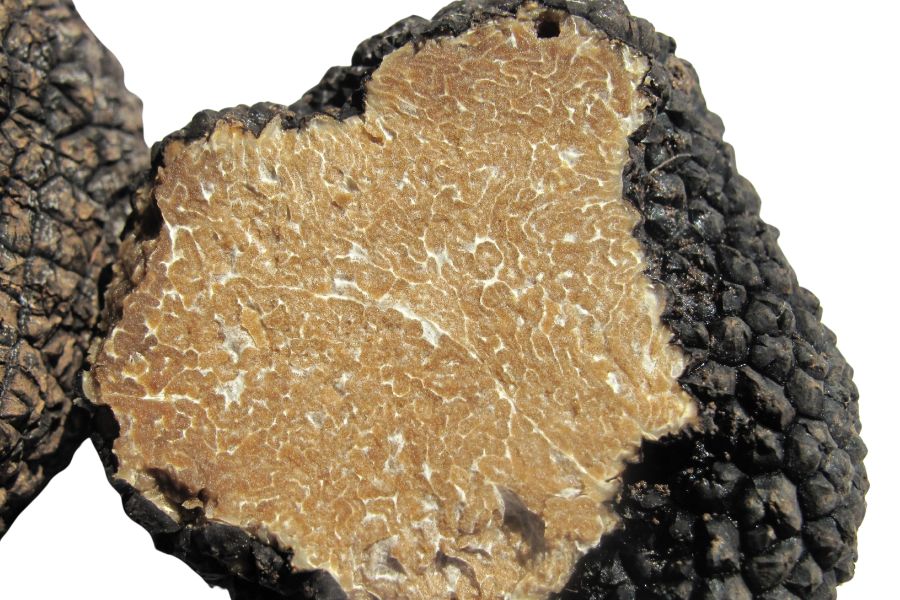Truffles are growing beneath the soil in certain parts of Oklahoma. These fancy fungi are prized by chefs and food lovers for their unique taste. They grow naturally in our state, even though many people don’t know it.
Oklahoma’s climate actually works well for some truffle types. Our mix of forests and farmland creates good spots where these treasures can grow. The soil conditions in parts of our state match what truffles need to thrive.
Hunting for truffles takes some know-how and patience. Most people use trained dogs to sniff out these underground treats. The dogs can smell the strong scent of ripe truffles through the soil.
The best time to look for truffles in Oklahoma is during fall and winter months. This is when the ground stays cool and moist. Truffles tend to grow near certain trees, making those areas good starting points.
Truffle hunting demands more from you than usual, and there are days you’ll return empty-handed. But with the right knowledge, your search could turn up not just truffles but a whole range of hidden treasures.
What We Cover In This Article:
- What Wild Truffles Look Like
- Truffle Lookalikes To Avoid
- Best Practices For Finding Truffles
- Where You Can Find Truffles Around The State
- Other Great Locations For Truffles
- When The Best Time Of The Year Is To Find Truffles
- The extensive local experience and understanding of our team
- Input from multiple local foragers and foraging groups
- The accessibility of the various locations
- Safety and potential hazards when collecting
- Private and public locations
- A desire to include locations for both experienced foragers and those who are just starting out
Using these weights we think we’ve put together the best list out there for just about any forager to be successful!
A Quick Reminder
Before we get into the specifics about where and how to find these plants and mushrooms, we want to be clear that before ingesting any wild plant or mushroom, it should be identified with 100% certainty as edible by someone qualified and experienced in mushroom and plant identification, such as a professional mycologist or an expert forager. Misidentification can lead to serious illness or death.
All plants and mushrooms have the potential to cause severe adverse reactions in certain individuals, even death. If you are consuming wild foragables, it is crucial to cook them thoroughly and properly and only eat a small portion to test for personal tolerance. Some people may have allergies or sensitivities to specific mushrooms and plants, even if they are considered safe for others.
The information provided in this article is for general informational and educational purposes only. Foraging involves inherent risks.
What Wild Truffles Look Like
The U.S. is home to several native truffle species that grow wild in forests across the country. Each one has its own unique scent, appearance, and preferred habitat. Here are the types of truffles you can find:
Oregon Black Truffles (Leucangium carthusianum)

Leucangium carthusianum, also called the Oregon black truffle, grows in the Pacific Northwest and usually shows up around Douglas-fir trees. It’s a native species and one of the more well-known edible truffles from the region.
On the outside, it looks like a small lump of coal—dark black, kind of lumpy or warty, and sometimes slightly smoother in spots. They’re usually about the size of a golf ball, but they can be smaller or larger depending on the season.
Inside, the truffle is firm with a marbled pattern of gray and white veins running through it. When it’s fresh, it smells fruity, almost like pineapple, but the scent gets stronger and muskier as it ripens.
If you’re out looking for them, check in moist, shady forests with soft, loamy soil, especially where there’s a lot of moss or ferns. They grow just below the surface, so people often use trained dogs to help sniff out the ripe ones.
Compared to the Oregon white truffle, which is lighter in color and has a sharper, garlicky aroma, the black truffle has a deeper, more earthy smell. It’s also bigger and firmer than the southern U.S. truffles like Tuber lyonii, which tend to be smaller, paler, and grow around hardwoods like oaks and hickories.
Oregon Winter White Truffles (Tuber oregonense and Tuber gibbosum)
Oregon has two native white truffles that are starting to get more attention: the Oregon Winter White Truffle (Tuber oregonense) and the Oregon Spring White Truffle (Tuber gibbosum). They grow underground in forests and are prized for their strong, savory aroma.
From the outside, these truffles are small, roundish, and kind of bumpy, usually pale beige to light brown. Cut one open, and you’ll see a white interior that darkens with age, showing off a web of white veins when it’s fully mature.
The Winter White Truffle pops up from late fall into February, while the Spring White starts showing up around January and can last into June. They’re pretty similar, but the Winter variety is known for having a more powerful scent and flavor.
To find them, you’ll want to look in forests with younger Douglas-fir trees on the west side of the Cascades. Truffle hunters often check for loose soil or spots where animals have been scratching, which can be a sign there’s something below.
When fully ripe, both types give off a bold smell that’s often compared to garlic, cheese, or earthy spices. They’re usually served raw, shaved over dishes to add that truffle kick without losing any of the aroma.
Appalachian Truffle (Tuber canaliculatum)
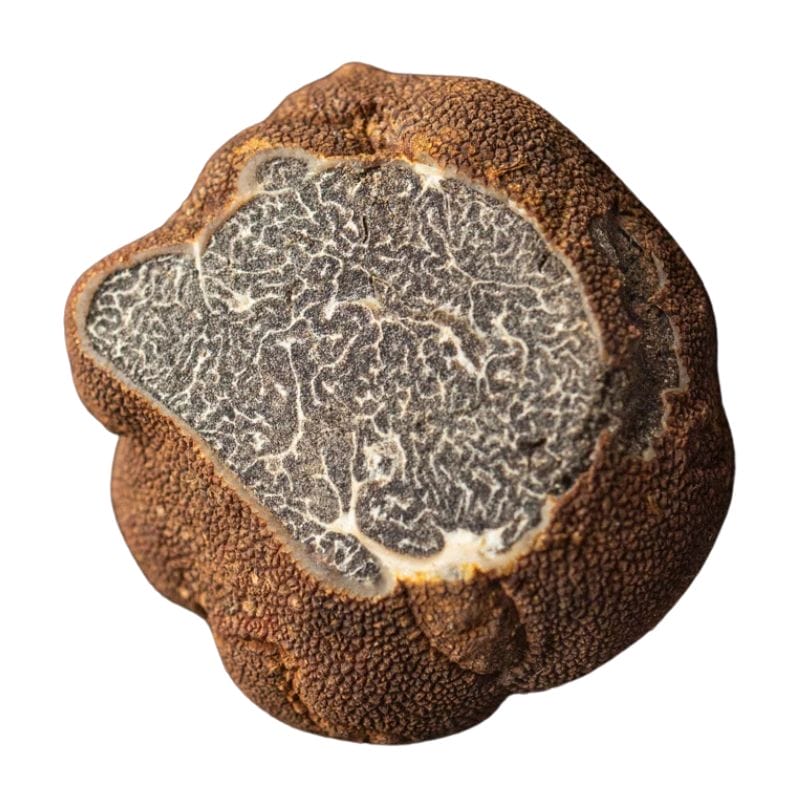
The Appalachian truffle, also known as Tuber canaliculatum, is a native North American truffle that’s slowly getting noticed. It’s about the size of a walnut and has a reddish-brown, bumpy outer surface that looks kind of like a rough, warty potato.
When you cut it open, the inside is firm and dark brown with thin white veins running through it like a marbled pattern. If it’s fully ripe, the smell is strong and earthy—some say it has a kind of nutty, funky aroma that stands out.
You can find these truffles in mixed hardwood forests, especially around oaks and pines, from late summer through fall. They grow underground, so look for spots where the soil is loose and animals like squirrels have been digging—sometimes that’s a good clue.
If you’re foraging, gently raking the top layer of soil near tree roots can help, but a trained dog or even a good nose makes it way easier. Once you know what to look for, the reddish color and bumpy skin are good signs you’ve found the right thing.
Compared to truffles like Tuber oregonense or Leucangium carthusianum, Tuber canaliculatum is more subtle in every way. Its smaller size and lighter scent mean you have to pay closer attention when foraging.
It’s also not as popular in the culinary world because it doesn’t pack the same punch in terms of flavor or aroma. Still, finding one can be rewarding, especially if you’re exploring different types of fungi in the area.
Desert Truffle (Terfezia and Tirmania spp.)
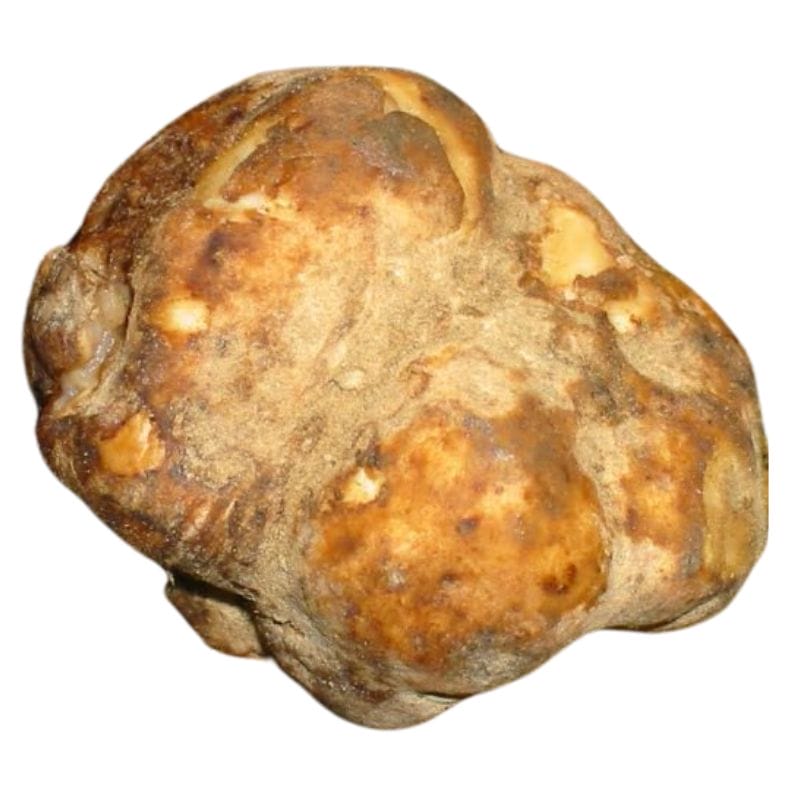
Terfezia and Tirmania are two types of truffles that are sometimes called desert truffles. These are a bit different from the truffles we usually think of, with their bold flavors and rich aromas.
These ones are a little more understated, but they’re fascinating in their own right. What makes them stand out is their ability to thrive in dry, harsh environments where you wouldn’t expect something so delicate to grow.
Unlike the earthy, intense aroma of black or white truffles, Terfezia and Tirmania truffles have a milder scent and flavor. They’re often described as nutty, with a hint of sweetness, but they lack the strong garlicky or musky notes you might associate with other truffles.
Their texture is also different—more firm and less oily than what you’d find with species like Tuber oregonense. They might not have the same culinary punch, but they’re still prized in traditional dishes, where their subtle flavors shine in simpler recipes.
When it comes to appearance, they’re easy to spot once you know what you’re looking for. They’re round to slightly irregular in shape, and their color can range from light beige to a reddish-brown, depending on the species.
The surface is usually smooth or slightly textured, without the rough, knobby look of a black truffle. Cut one open, and you’ll see a pale interior that’s often uniform in color, lacking the intricate veining you’d see in something like Leucangium carthusianum.
Pecan Truffle (Tuber lyonii)
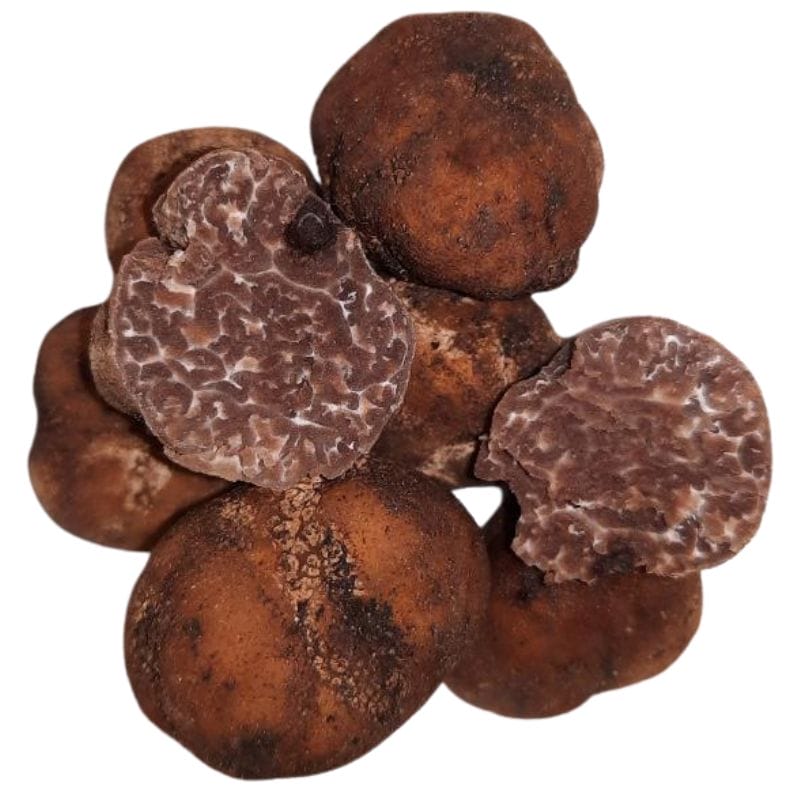
Tuber lyonii, also known as the pecan truffle, is a native North American truffle that grows underground near the roots of pecan trees. You’ll mostly find it in the southeastern U.S., especially in states like Texas, Georgia, and Mississippi.
On the outside, pecan truffles are round to lumpy and have a smooth, light brown skin that darkens as they age. They’re usually about the size of a marble or golf ball, and sometimes they even poke up slightly through the soil surface.
If you slice one open, the inside has a pretty marbled look—light tan streaks mixed with darker brown, almost like wood grain. The smell is earthy, nutty, and kind of warm, especially when they’re fully mature.
When you’re out looking for them, check under mature pecan trees or other hardwoods like oaks and hickories. Trained dogs can help sniff them out, but people sometimes spot them by looking for little cracks in the soil or raised areas near the tree’s base.
Compared to other U.S. truffles like the Oregon white truffle or the Appalachian black truffle, pecan truffles have a milder flavor and are more common in orchards. They’re a solid option in the kitchen—freshly sliced over pasta or mixed into butter—and they don’t come with the high price tag of their European cousins.
Truffle Lookalikes To Avoid
When you’re out hunting you also need to know about a few different fungi species that look very similar to the delicious truffles we’re after but are either inedible or not worth eating. Keep an eye out for:
Pine Truffles (Geopora cooperi)
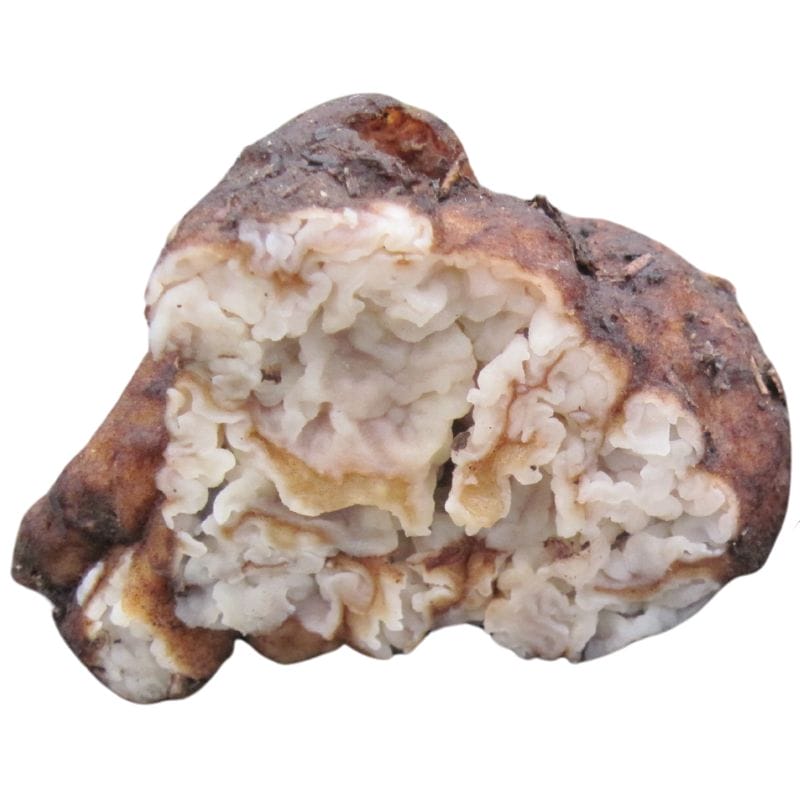
Geopora cooperi is a fungus that can easily confuse someone new to truffle hunting. It’s sometimes called the pine truffle because it grows underground like a true truffle and often pops up near certain trees.
At first glance, it might seem like you’ve hit the jackpot, but this one is a false truffle, not something you’d want to eat or sell.
The easiest way to tell Geopora cooperi apart from real truffles is by looking closely at its structure. While true truffles have a smooth or slightly knobby exterior and a marbled interior, Geopora cooperi has a rougher, more irregular outer surface.
When it matures, it sometimes splits open, revealing a cup-like shape, which true truffles never do. Inside, it’s less dense and doesn’t have the intricate veining that makes real truffles so unique.
Another big difference is the smell. True truffles have a strong, rich aroma that’s earthy, sweet, or garlicky, depending on the species. Geopora cooperi, on the other hand, has a much weaker scent, and it’s not as pleasant or distinctive.
If you’re relying on aroma to identify your find, this one will give itself away pretty quickly. So, while it might look similar at first, a closer inspection will show it’s not the culinary treasure you’re hoping for.
Stinking Slime Truffle (Melanogaster ambiguus)
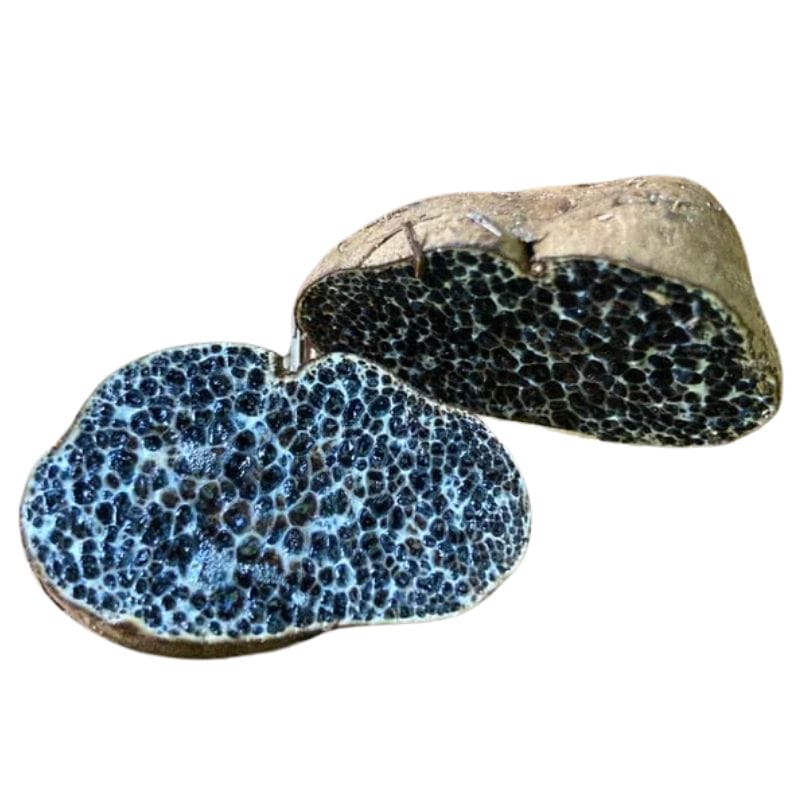
Melanogaster Ambiguus, because of their reddish-brown to dark brown exterior, might look like true truffles at first glance, but they’re quite different when you know what to look for.
The key difference is on the inside. When you cut open Melanogaster ambiguus, the interior is filled with flattened cells that have a shiny black gelatinous feel to them. Real truffles, on the other hand, have those beautiful marbled veins running through their flesh, almost like a web.
Another giveaway is the smell. While real truffles have a rich, earthy aroma that’s mouthwatering, Melanogaster ambiguus tends to have a much stronger, almost unpleasant odor—it’s not something you’d want to sprinkle on your pasta.
Earthballs (Scleroderma)
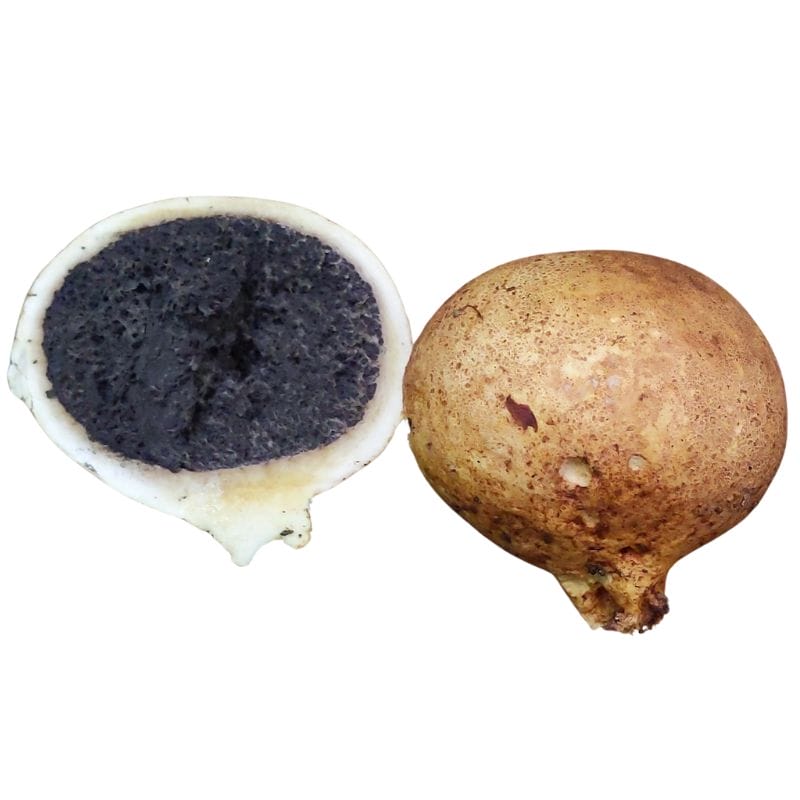
Scleroderma, commonly called earthballs, can easily fool someone who’s just starting out because they grow underground and have a round shape similar to truffles. But don’t be tricked—Scleroderma is not a true truffle, and it’s actually toxic, so it’s important to know how to tell the difference.
The first thing you’ll notice is the outer skin, which is thicker and tougher than that of most truffles. It can range in color from yellowish to dark brown, often with a rough or cracked texture.
If you cut it open, the difference becomes even clearer. While true truffles have a marbled interior with delicate white veins, Scleroderma starts out with a whitish inside that quickly darkens as it matures, turning black or purple with no marbling. It’s dense and solid, almost like charcoal in the later stages.
Another big giveaway is the smell. True truffles have a rich, earthy aroma that makes them so prized, while Scleroderma has little to no pleasant scent—some even describe it as musty or unpleasant.
Deer Truffles (Elaphomyces)
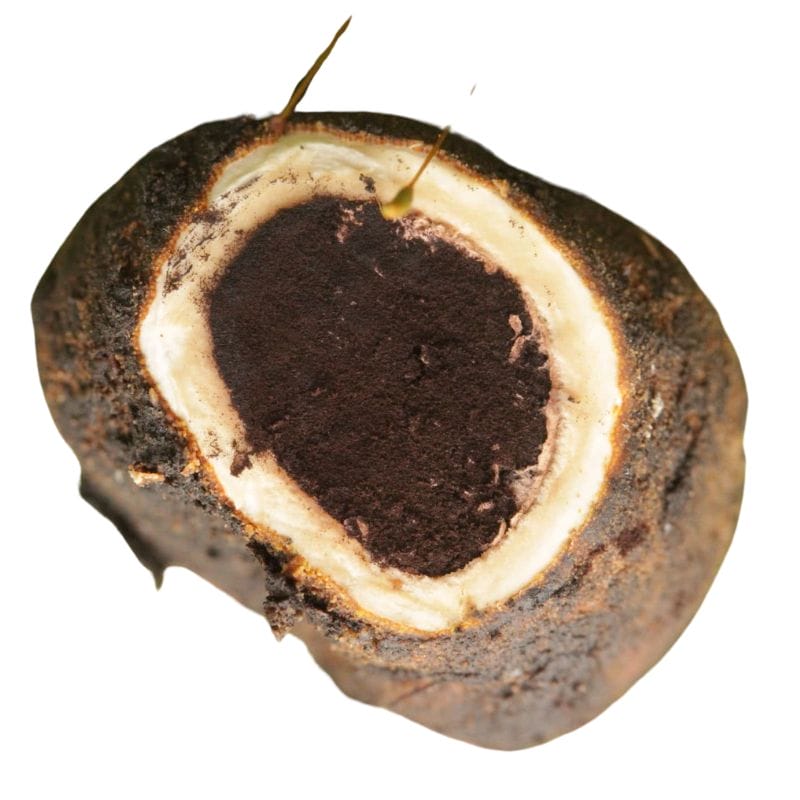
Elaphomyces, also known as deer truffles, look like true truffles at first glance, but they’re a whole different story. They’re called deer truffles because wildlife, especially deer and rodents, love to eat them. For us humans, though, they’re not edible—and definitely not what you want to mistake for a prized truffle.
Here’s how you can tell Elaphomyces apart from the real thing. First, they have a tough, warty outer surface that can range from pale tan to black, depending on the species and their age.
When you cut them open, the inside is solid and sometimes speckled or marbled, but not in the delicate, vein-like pattern you’d see in true truffles.
Their smell is also a big giveaway. Instead of the rich, earthy aroma of an edible truffle, Elaphomyces either has little scent or an odor that’s earthy but not particularly appealing.
Another thing to know is that Elaphomyces often grows deeper in the soil than true truffles, and they tend to have a harder, woodier texture.
Best Practices For Finding Truffles
Truffle hunting can be a rewarding adventure if you know the right tips and tricks. Here’s what you should keep in mind to improve your chances of finding these underground treasures:
Wait 10 to 14 Days After Heavy Rain
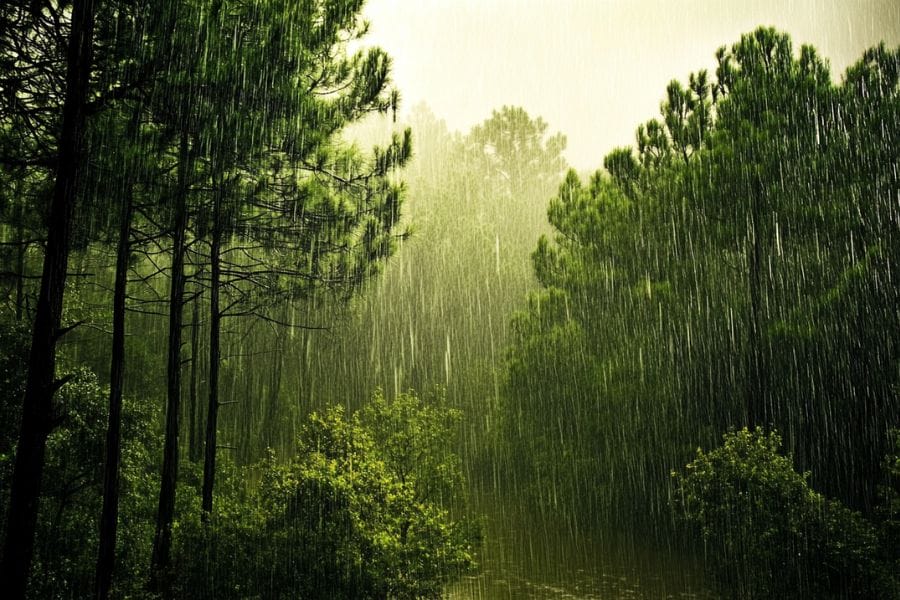
After a heavy rain, it’s best to wait about 10 to 14 days before heading out. This gives the truffles time to mature and release their signature aroma, making it easier for you (and your dog) to sniff them out. Rain helps truffles grow, but they don’t start giving off their scent right away.
As the soil warms up, the truffles get more aromatic, and the ground becomes looser, which makes digging easier without disturbing the environment too much. The timing is perfect to find truffles at their best—both in quality and in how easy they are to locate.
Find the Right Trees
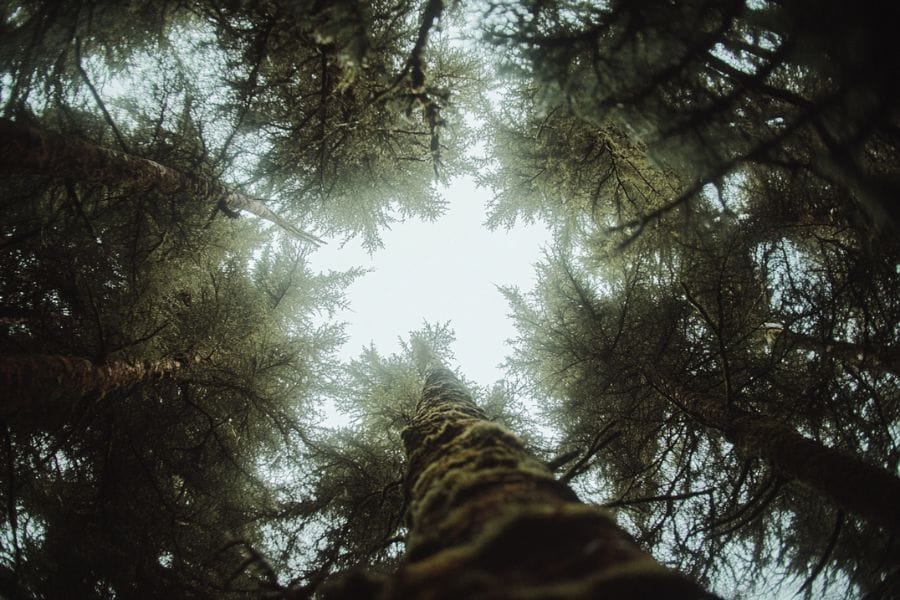
Truffles don’t grow just anywhere—they have a special relationship with certain trees. You won’t find them under just any tree, so knowing which ones to look for can make all the difference. Some of the best trees to look out for are:
- Pines
- Douglas-firs
- Oaks
- Hazelnuts
- Cypresses
- Willows
For example, if you’re looking for Oregon white truffles, keep an eye out for Douglas-fir trees. California black truffles, on the other hand, are often found near oaks and hazelnuts. The soil around these trees also needs to be slightly alkaline, so it helps to know what kind of ground you’re walking on as well.
Watch for Wildlife Activity
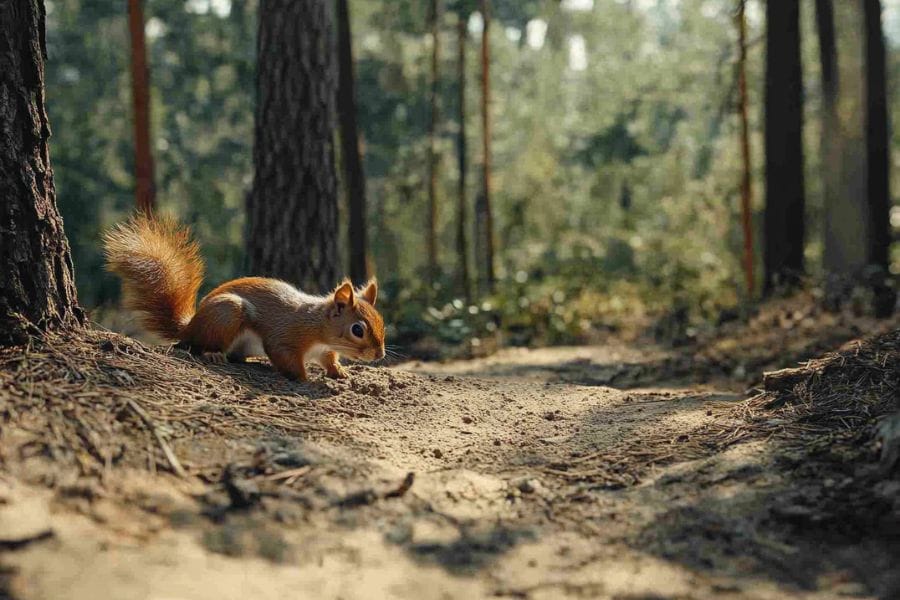
Animals like squirrels and chipmunks often help spread truffle spores, and sometimes their digging can lead you straight to truffles. While you won’t always find truffles in every pit animals dig (they also look for things like acorns or bulbs), fresh digs are a good clue. The more recent the pit, the better chance it has of leading to truffles.
Even though animals are a part of the truffle cycle, most hunters prefer using dogs to find the real treasure underground. Dogs have an incredible nose for truffles and can pinpoint their location much more reliably than any squirrel or chipmunk.
Get a Little Help from a Truffle-Hunting Dog
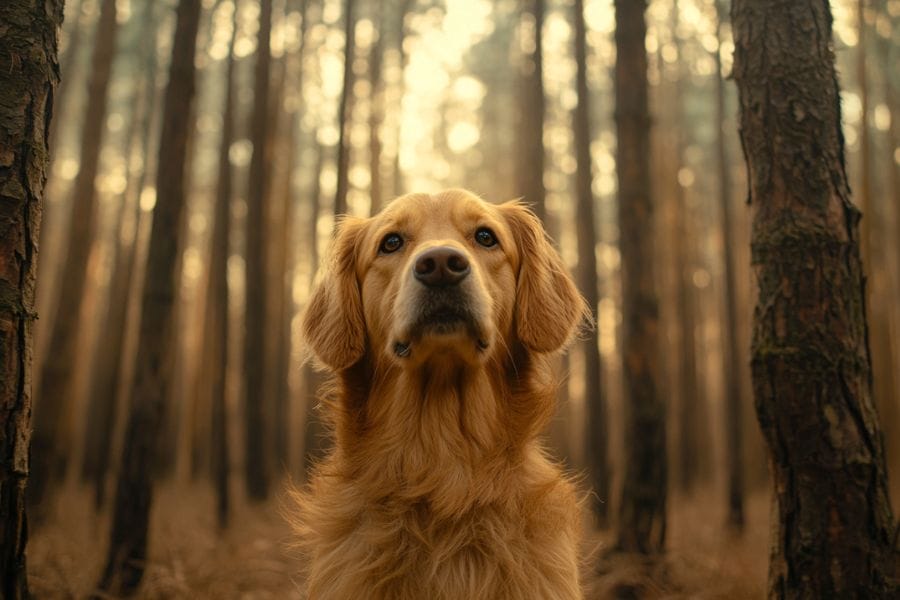
If you’re serious about truffle hunting, a trained dog can make your life a whole lot easier. Their sense of smell is extraordinary, and they’re trained to find mature truffles buried beneath the surface. Many truffle hunters swear by their dogs, and for good reason—they’re much more accurate than humans when it comes to sniffing out truffles.
If you don’t already have a trained dog, you can connect with local foraging groups or specialized trainers who offer truffle-hunting services. Some places even host events where you can see experienced handlers with their dogs in action. And if you’re feeling adventurous, you can train your own dog using truffle-scent kits and practice in a controlled space before hitting the woods.
Before you head out
Before embarking on any foraging activities, it is essential to understand and follow local laws and guidelines. Always confirm that you have permission to access any land and obtain permission from landowners if you are foraging on private property. Trespassing or foraging without permission is illegal and disrespectful.
For public lands, familiarize yourself with the foraging regulations, as some areas may restrict or prohibit the collection of mushrooms or other wild foods. These regulations and laws are frequently changing so always verify them before heading out to hunt. What we have listed below may be out of date and inaccurate as a result.
Where You Can Find Truffles Around The State
Now we’re going to go over five of the best locations for finding truffles. We’ll go a bit in-depth here and then provide a much longer list of other spots to try.
Chickasaw National Recreation Area

Chickasaw National Recreation Area sits in south-central Oklahoma near the town of Sulphur. The park mixes forests, streams, and rocky areas that truffles love to grow in. Many oak trees grow here, which often form special relationships with truffles underground.
Look for truffles along Rock Creek and Travertine Creek where the ground stays moist. The best spots are usually around older oak trees where the soil isn’t too hard. Try the eastern part of the park near Veterans Lake, where other hunters have had good luck.
After it rains is the best time to hunt for truffles here. Bring a small rake to gently move the top soil around. The limestone in the ground makes the soil just right for certain types of truffles to grow.
Ouachita National Forest
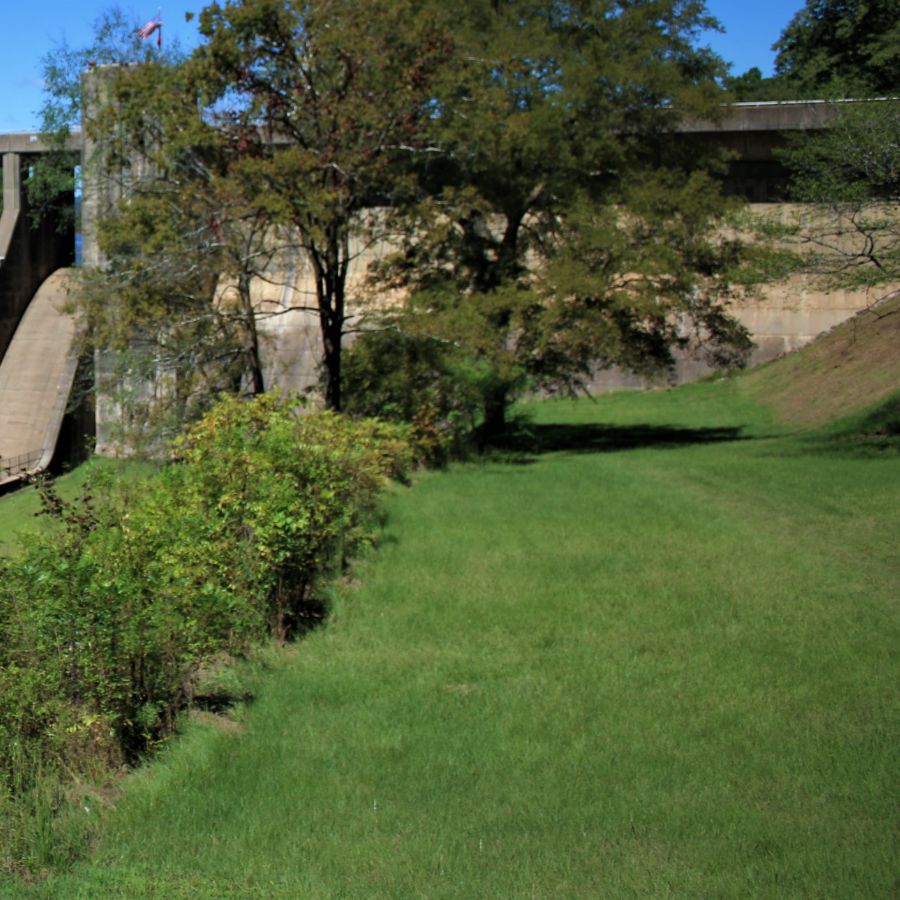
Ouachita National Forest covers parts of southeastern Oklahoma and western Arkansas. This huge forest has many different trees and plants that create the perfect home for truffles. The thick layer of dead leaves on the ground helps keep moisture in the soil.
Many truffles grow near the Little River area around the roots of oak trees. Look for places where the ground slopes gently because water drains well but still keeps some moisture. Sometimes deer dig up the ground looking for truffles, so these spots are worth checking.
The Beech Creek area stays shady and cool, which truffles really like. When hunting, watch for small bumps in the ground or areas that look slightly raised. These might be signs that truffles are growing just below the surface.
Robbers Cave State Park
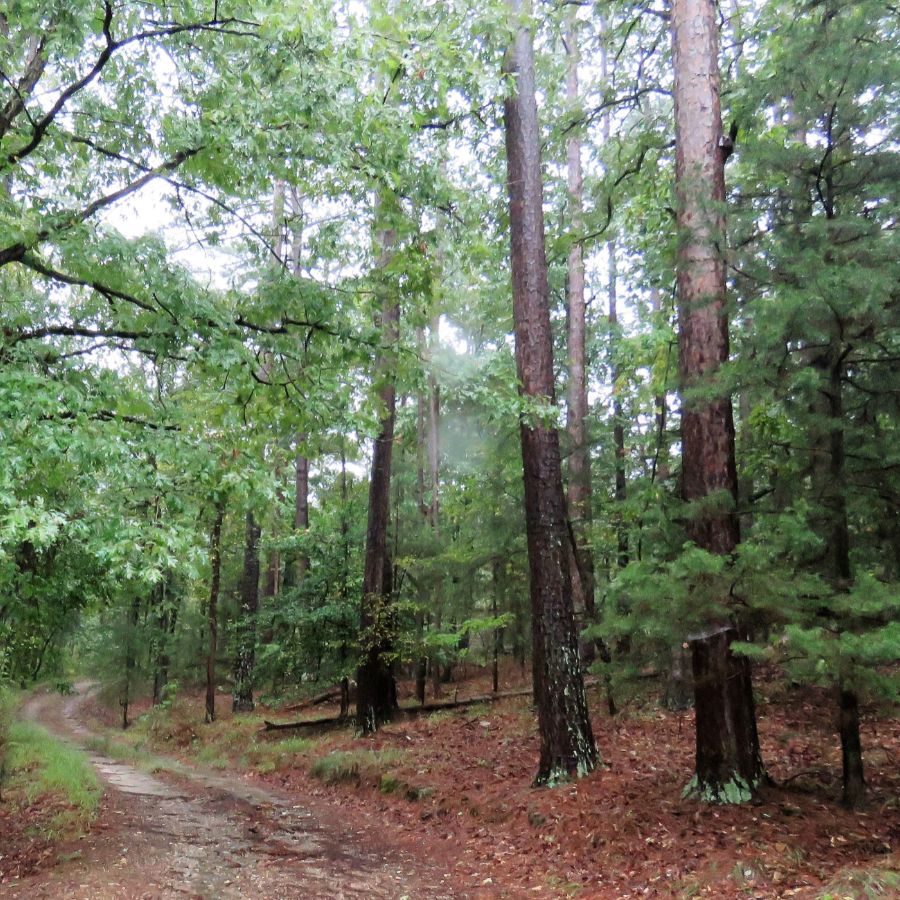
The Robbers Cave State Park is found in the Sans Bois Mountains in southeastern Oklahoma. The park gets its name from a cave where outlaws used to hide. Its mix of hills, cliffs, and woods creates many different places where truffles can grow.
Truffles often grow in the lower parts of the park where water collects. Try looking around Lake Carlton and Lake Wayne Wallace, where the soil is rich. The north-facing slopes stay cooler and wetter, making them good spots to check.
Different parts of the park have different mini-climates. This means you might find various types of truffles as you explore. The Belle Starr View area has lots of oak trees and good soil where truffles like to grow.
Wichita Mountains Wildlife Refuge

Wichita Mountains Wildlife Refuge protects an ancient mountain range in southwestern Oklahoma. The unique mix of grassy plains and oak woodlands creates special places for truffles. The soil here contains minerals from granite rock that help truffles grow.
Try hunting around the oak trees near Medicine Park or in quiet wooded areas away from busy trails. The best places are often under post oaks and blackjack oaks where the tree shade keeps the ground cool. Different elevations in the refuge create areas with varying amounts of moisture.
The area around Quanah Parker Lake combines water and mature trees, making it great for truffles. French Creek also has a good variaty of trees and soil that hasn’t been disturbed much.
Keystone State Park

Keystone State Park is located near Tulsa on the shores of Keystone Lake. The humid air from the lake helps fungi grow in the park’s woodlands. Oak, hickory, and elm trees create a canopy that protects the forest floor.
The northern parts of the park see fewer visitors, making them better for finding untouched truffles. Look in areas where the woods meet open spaces, as these edge zones often have more truffle activity. Some hunters watch for places where squirrels have been digging, as these animals somtimes find truffles.
Eagle Creek has good tree coverage and mature oaks that support truffle growth. The park’s rolling hills provide good drainage while still keeping the soil moist enough for truffles. Remember to bring a small rake and a bag with holes to carry your finds.
Other Great Locations For Truffles
Northwest Oklahoma
| Location | Allowed Truffle Collection |
|---|---|
| Beaver River WMA | Public can collect truffles and wild fungi during open-access periods. No digging during controlled hunts. |
| Beaver River WMA – McFarland Unit | Mushroom and truffle foraging is allowed during non-hunting seasons. Stay on public paths. |
| Black Kettle WMA | Truffle collection is permitted in non-campground wooded areas. |
| Boiling Springs State Park | Wild mushroom and truffle digging is allowed throughout open areas. |
| Cimarron National Grassland | Foraging for native truffles is allowed in undeveloped sections of the park. |
| Little Sahara State Park | Foraging for native truffles allowed in undeveloped sections of the park. |
Northeast Oklahoma
| Location | Allowed Truffle Collection |
|---|---|
| Arbuckle Springs WMA | Truffle and mushroom collecting are permitted when wildlife areas are open to public. |
| Barren Fork WMA | Collection of native fungi, including truffles, is allowed during public access windows. |
| Cherokee WMA | Fungi collection, including truffles, is allowed during general access dates. |
| Greenleaf State Park | Wild truffle foraging is permitted away from the salt flats. |
| Great Salt Plains State Park | Truffle hunting is allowed in forested trails, but no digging near facilities. |
| McCurtain County Wilderness Area | Collection of native fungi, including truffles, allowed during public access windows. |
Central Oklahoma
| Location | Allowed Truffle Collection |
|---|---|
| Arcadia Conservation Education Area | Truffle and wild mushroom digging are permitted in natural areas. |
| Black Mesa State Park | Truffle foraging is allowed in wooded areas; do not disturb marked restoration zones. |
| Cross Timbers State Park | Wild fungi collection is allowed when not restricted for game management. |
| Fort Gibson WMA | Truffle foraging is allowed near creek beds and wooded trails. |
| Honey Creek State Park | Digging for truffles is permitted along designated hiking paths. |
| Lake Thunderbird State Park | Truffle collection is permitted in undeveloped canyon forested areas. |
| Red Rock Canyon State Park | Truffle collection permitted in undeveloped canyon forested areas. |
Southeast Oklahoma
| Location | Allowed Truffle Collection |
|---|---|
| Bishop Butte WMA | Truffle foraging is permitted near water-adjacent wooded regions. |
| Blue River Public Fishing & Hunting Area | Foraging for mushrooms and truffles is permitted in allowed zones. |
| Broken Bow WMA | Wild fungi digging is allowed in timbered parts of the area. |
| Fontana WMA | Truffle hunting is allowed in all non-developed forest sections. |
| Ouachita National Forest | Truffle collection is allowed away from campgrounds and cabin zones. |
| Robbers Cave State Park | Truffle and mushroom digging are allowed in open-access public areas. |
| Waldron WMA | Truffle and mushroom digging allowed in open-access public areas. |
Southwest Oklahoma
| Location | Allowed Truffle Collection |
|---|---|
| Altus-Lugert WMA | Truffle foraging permitted outside closed hunt dates. |
| American Horse WMA | Truffle digging is permitted in shady woodland pockets of the park. |
| Black Mesa State Park (SW section) | Native fungi foraging, including truffles, is allowed in grassland forest edges. |
| Gloss Mountain State Park | Foraging for truffles is allowed in designated walking zones. |
| Salt Plains National Wildlife Refuge | Mushroom and truffle collection is permitted in non-restricted public zones. |
| Wichita Mountains Wildlife Refuge | Mushroom and truffle collection permitted in non-restricted public zones. |
South-Central Oklahoma
| Location | Allowed Truffle Collection |
|---|---|
| Camp Gruber WMA | Truffle digging is allowed near lake trails and picnic woodlands. |
| Fort Cobb State Park | Foraging for truffles is permitted when area is open to non-hunting access. |
| Robinson WMA | Public may collect wild truffles except during peak hunting periods. |
| Sallisaw WMA | Digging for truffles is allowed along hiking trails and non-developed areas. |
| Talimena State Park | Digging for truffles allowed along hiking trails and non-developed areas. |
When The Best Time Of The Year Is To Find Truffles
In Oklahoma, truffle hunting season peaks from late November through February when the soil holds the right moisture balance. Winter rains provide the humidity truffles need without the extreme heat that damages them.
January is often the sweet spot when temperatures hover between 40-55°F, creating ideal growing conditions. Unlike other regions, Oklahoma’s brief mild winter means the season is shorter but intense.
After a cold snap followed by a few days of warmer weather is the perfect time to search, as this temperature fluctuation often triggers truffle maturation. Local hunters report the strongest aromas and best finds after these weather shifts.
One Final Disclaimer
The information provided in this article is for general informational and educational purposes only. Foraging for wild plants and mushrooms involves inherent risks. Some wild plants and mushrooms are toxic and can be easily mistaken for edible varieties.
Before ingesting anything, it should be identified with 100% certainty as edible by someone qualified and experienced in mushroom and plant identification, such as a professional mycologist or an expert forager. Misidentification can lead to serious illness or death.
All mushrooms and plants have the potential to cause severe adverse reactions in certain individuals, even death. If you are consuming foraged items, it is crucial to cook them thoroughly and properly and only eat a small portion to test for personal tolerance. Some people may have allergies or sensitivities to specific mushrooms and plants, even if they are considered safe for others.
Foraged items should always be fully cooked with proper instructions to ensure they are safe to eat. Many wild mushrooms and plants contain toxins and compounds that can be harmful if ingested.

